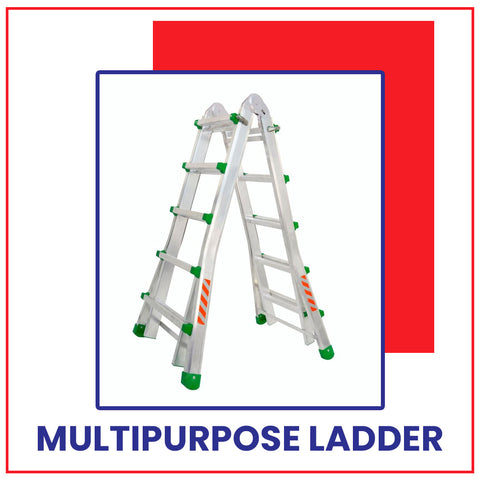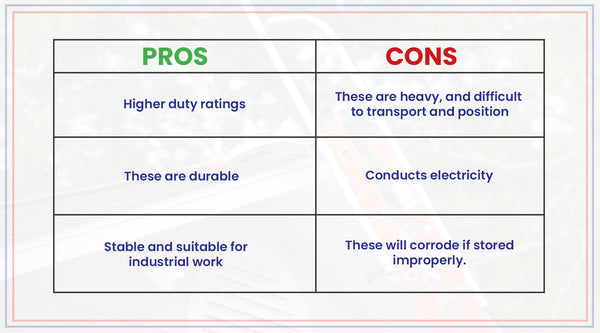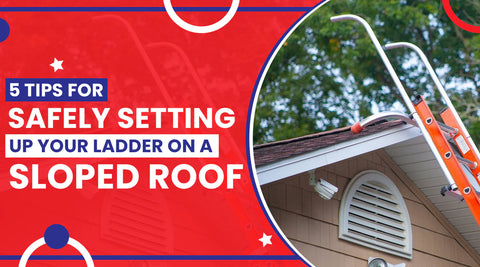
Ladders are essential tools for simple repairs and fixes, whether it's fixing your roof or your beautiful chandelier lamp on the ceiling. However, it's crucial to understand the types of ladders suitable for specific tasks to ensure safety and prevent accidents.
In this article, we will discuss different types of ladders, the materials they are made of, and ladder rating types. Ladder safety is our top priority, and we want you to understand the basics to choose the perfect ladder for your fixes and tasks.
What are Ladder classifications?

When deciding on ladders, it's essential to understand the various types available. For example, some ladders have an 'A-frame' structure, making it easier to maintain balance on uneven surfaces.
Additionally, the material of the ladder can play a vital role depending on its intended use. Furthermore, opting for portable ladders can make transportation easier. Therefore, depending on your needs and considering factors that affect safety, it's important to choose the ideal ladder.
What are Different Types of Ladders?

Here the different types of ladders:
-
Step Stool:

A compact, foldable step stool with one or two steps is perfect for quick, light-duty indoor tasks. Its small but sturdy frame allows you to easily reach high shelves, cabinets, or perform minor activities like changing lightbulbs. Step stools provide just enough height for small jobs without taking up much storage space.
-
Step Ladder:

Step ladders have a self-supporting A-frame design that creates a stable base without needing a wall for balance. This makes them safe to use in open rooms. Step ladders come in various heights, typically reaching up to 20 feet. Their folding design with hinged rails makes storage simple. They work well for indoor painting, decorating, maintenance, or light outdoor jobs.
-
Extension Ladder:

Extension ladders have multiple sliding sections that lock at customized heights up to 72 feet, making them essential for accessing roofs, painting tall exteriors, or industrial facilities. They must lean securely against a wall at the proper angle and be anchored at the base by a helper for optimal safety while climbing at heights.
-
Telescoping Ladder:

Telescoping ladders combine compact storage with adjustable height by using internal rails that stretch out to extend the ladder’s length as needed, up to 16 feet. This single-section reach saves storage space versus carrying separated ladders. Like extension models, they still require a sturdy anchor point to lean against when fully elevated since they lack standalone support.
-
Folding Ladder:

Folding ladders are adjustable cousins of traditional A-frame step ladders, able to reach up to 21 feet when fully expanded. Multiple hinges allow custom widths and heights to suit varied jobs. When not needed, they collapse into a narrow shape for transport or stowing. The broad steps and optional side railings make folding ladders quite stable in use, even on uneven ground.
-
Platform Ladder:

Platform ladders build off time-tested A-frame step ladder designs but incorporate a standing deck at the top for the user and/or tools/materials. This allows safely working for longer periods without standing directly on ladder rungs or steps. There are also rolling scaffold designs with integrated guardrails for heavy-duty construction/maintenance jobs.
-
Straight Ladder:

Simple, non-adjustable straight ladders have a single set of equally spaced rails bridged by rungs. Ranging from 4 – 30 feet tall, they suit basic outdoor access jobs where adjustable reach is unnecessary. Though bulkier, their uncomplicated build makes them affordable and durable.
-
 :
:
Multipurpose ladders fold into different shapes like step ladders, straight ladders, trestles, or scaffolding to tackle varied jobs. The articulating hinged rails adjust to resemble other ladder types or be positioned at unique angles tailored to a particular task. If your work involves tackling diverse projects regularly, this adaptable ladder aims to replace owning multiple models.
What are Ladders Made Of?

Ladders are constructed from various materials, each with its own advantages and disadvantages. Common materials include aluminum, wood, fiberglass, and steel. When selecting a ladder, it's important to consider which material best suits the intended task and fits within your budget. For instance, if you'll be working with electrical wires, it's advisable to steer clear of aluminum ladders. Explore our list of ladder materials and their respective pros and cons to assist in determining the most suitable ladder for your needs.
-
Aluminum Ladders
Aluminum ladders are lightweight and budget-friendly options commonly found in the market. They are easy to transport and set up, making them suitable for various projects. However, it's essential to avoid using aluminum ladders near electrical sources or power lines as aluminum conducts electricity, which could lead to fatal accidents. Additionally, aluminum ladders can absorb heat and cold, affecting working conditions.

-
Wooden Ladders
Wooden ladders, although less common than fiberglass or metal options, are still suitable for specific contexts. Unlike aluminum, they are non-conductive and can be used in nearly any setting. However, their durability may be questionable, which could deter some users despite their affordability.

-
Fiberglass Ladders:
Fiberglass ladders, although the most expensive option, offer numerous benefits. They are non-conductive, durable, and temperature-resistant, making them suitable for various industrial or home projects.

-
Steel Ladders:
Steel ladders are ideal for heavy-duty industrial work, offering resilience and stability. While durable, they are susceptible to rusting if not stored properly. Some ladders are made of stainless steel to reduce corrosion damage, but it's crucial to ensure safe storage to maintain their structural integrity.

Various Ladder Ratings:
Understanding ladder ratings is crucial for ensuring maximum safety. Ladder duty ratings indicate the maximum weight capacity the ladder can safely hold. Exceeding this weight limit significantly increases the risk of the ladder becoming unstable and unsafe. Therefore, it's important to select a ladder with a duty rating that can accommodate your weight and any additional items you plan to carry.
You can typically find a ladder's duty rating on the specifications label or on a Duty Rating sticker attached to the ladder. Below, we've provided an overview of the five ladder ratings:

- Type III: Light-duty ladder with a maximum weight capacity of 200 pounds.
- Type II: Medium-duty ladder with a maximum weight capacity of 225 pounds.
- Type I: Heavy-duty ladder with a maximum weight capacity of 250 pounds.
- Type IA: Extra heavy-duty ladder with a maximum weight capacity of 300 pounds.
- Type IAA: Super duty ladder with a maximum weight capacity of 375 pounds.
To determine the appropriate ladder rating for your needs, calculate the combined weight of yourself, your clothing and equipment, and any additional tools and supplies you intend to carry on the ladder.
Conclusion:
In conclusion, understanding the different types of ladders, their materials, and ratings is essential for ensuring safety and efficiency in various tasks. Whether you're looking for a lightweight and portable solution like aluminum ladders or a durable option like fiberglass ladders, there are pros and cons to consider for each material. Additionally, being aware of ladder duty ratings helps determine the maximum weight capacity for safe usage.
Why to choose Ladder Safety devices with your ladder?
Ensure safety and stability with Ladder Safety Rails, offering an innovative ladder stabilizer for roof and hand rail systems. With Original Softouch Bumpers providing non-slip support, we prioritize safety to make your extension ladder experience safer and more secure.
FAQ
-
What are the three main types of portable ladders?
The three main types of portable ladders are step stools, step ladders, and extension ladders, each designed for different heights and purposes.
-
What type of ladders may be used in a trench?
Trench ladders are typically designed with a flat surface to provide stability on the ground and may include features like non-slip feet or spurs for added security.
-
How to use an extension ladder?
To use an extension ladder, ensure it's on stable ground, extend it to the desired height, lock the sections into place, and angle it properly against the structure you're climbing.
-
What is OSHA ladder safety?
OSHA ladder safety guidelines include inspecting ladders for defects before use, maintaining three points of contact while climbing, and never standing on the top rung.
-
What is the maximum height for a ladder?
The maximum height for a ladder depends on its type and duty rating, but in general, extension ladders can reach up to 72 feet when fully extended, while other types have varying height limits.
Read More Blogs Here:






